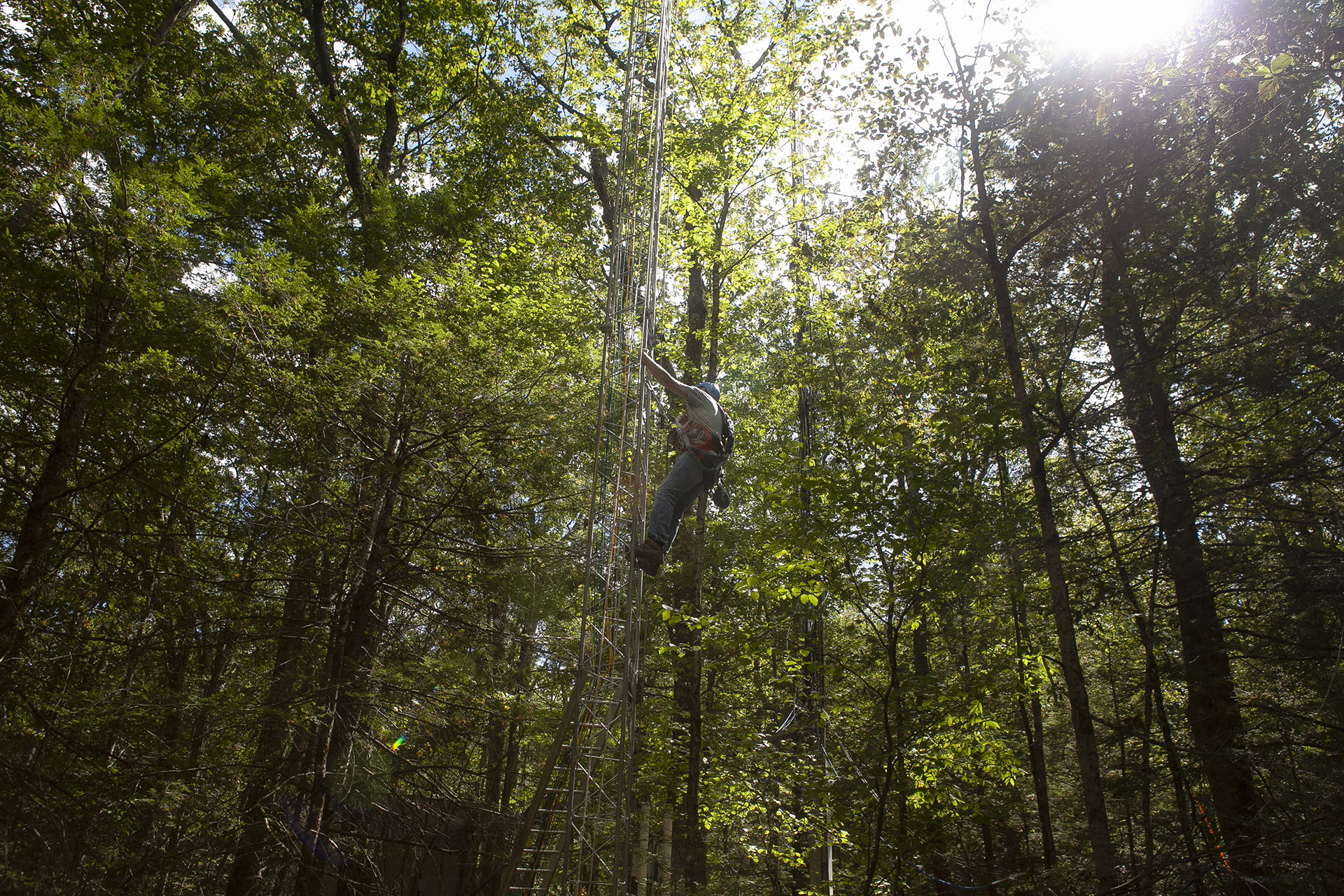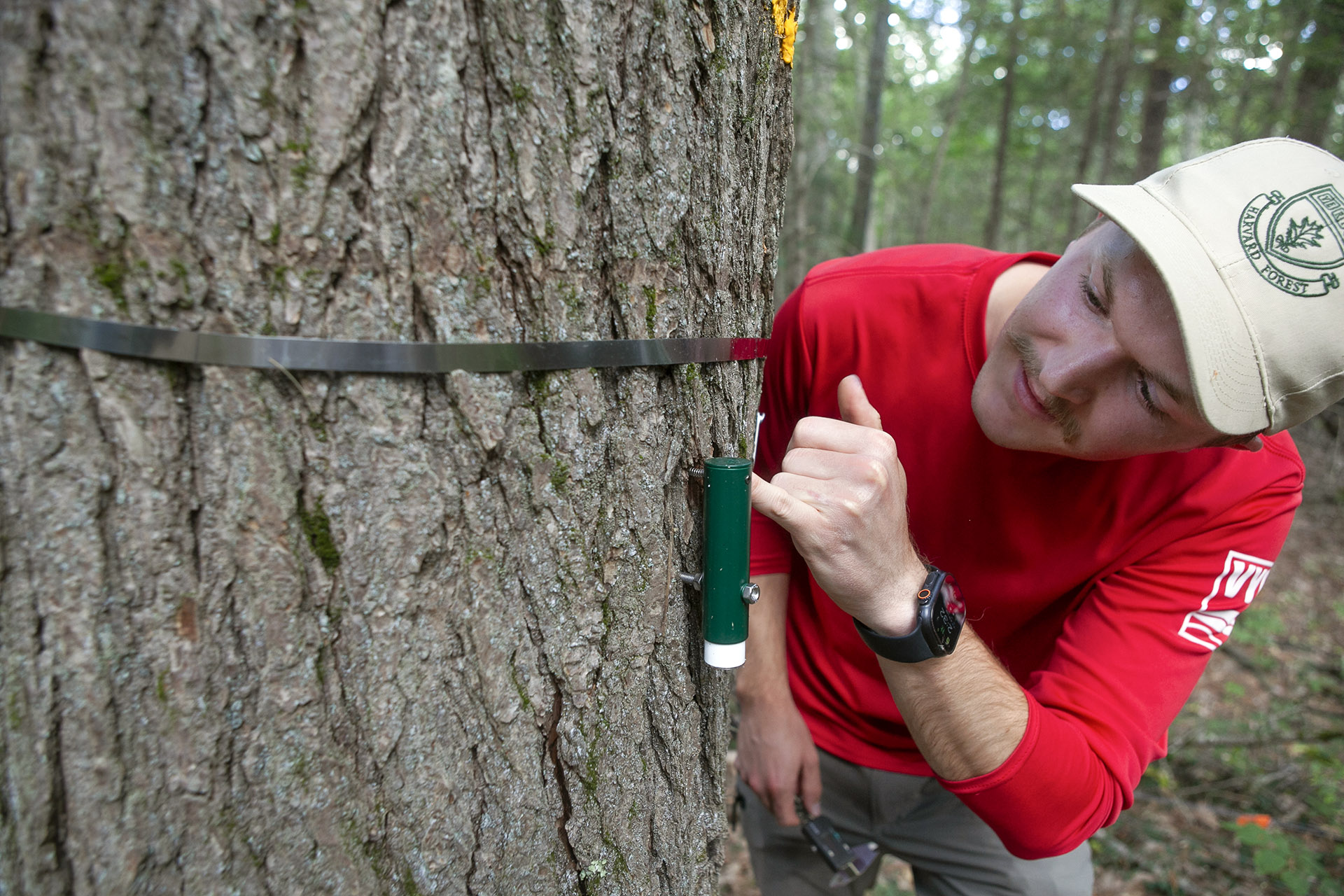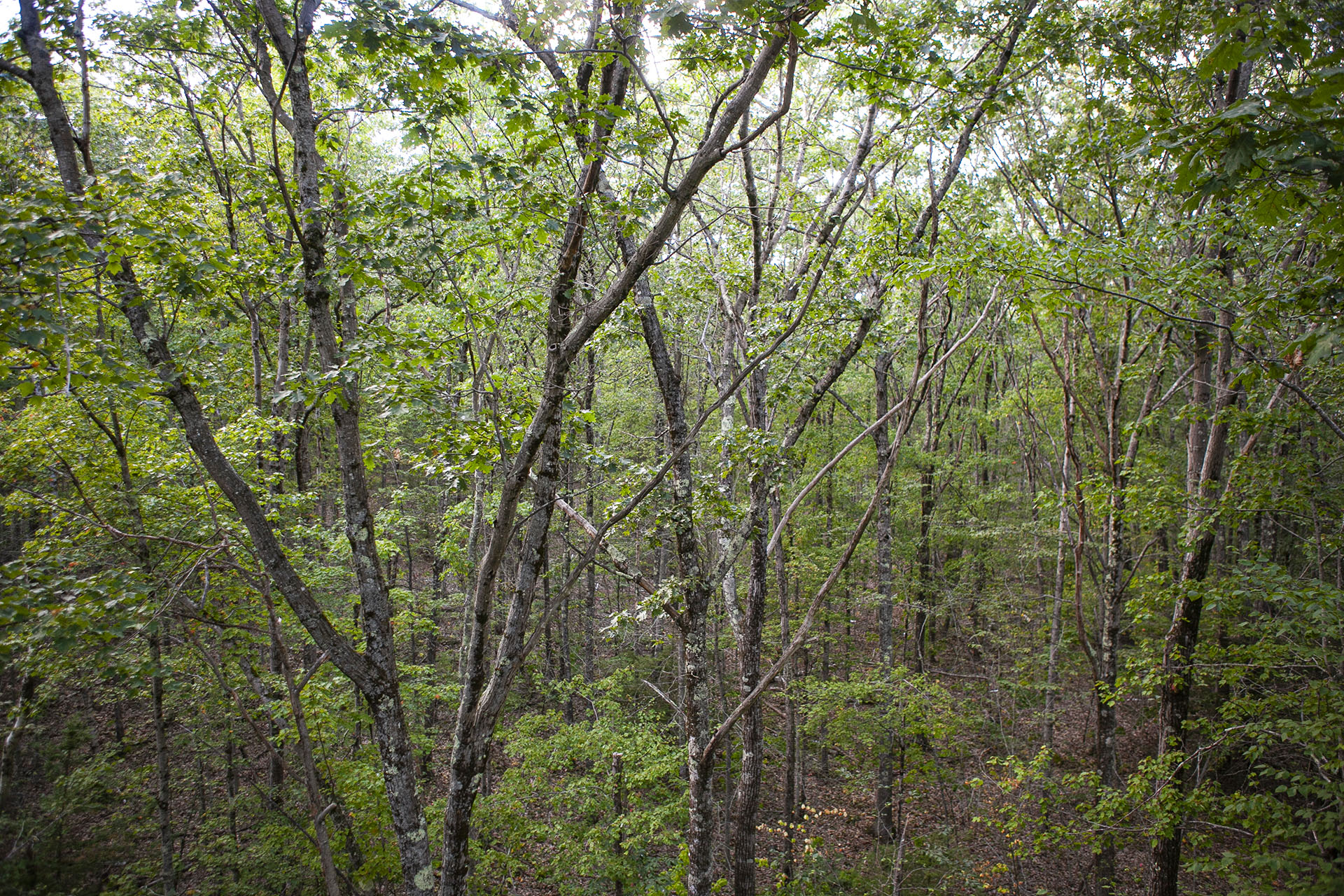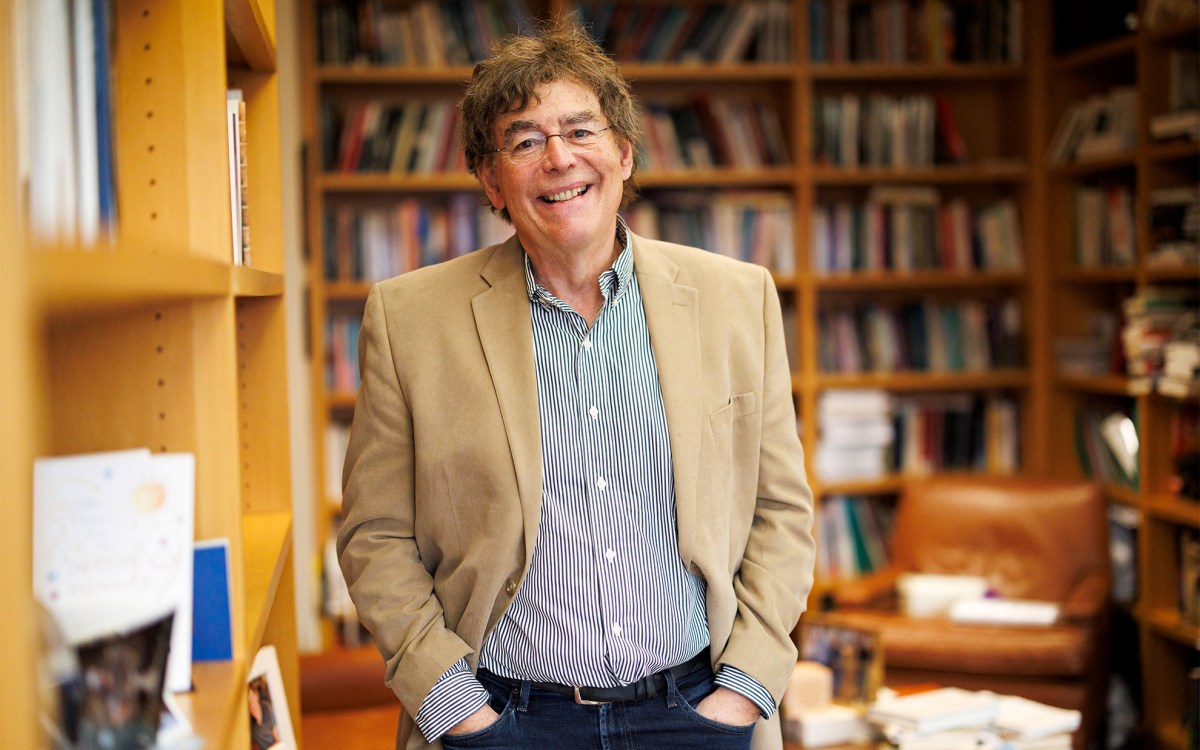Tracking climate change through nature’s ‘breaths’

Photos by David Trilling
New research tower monitoring Harvard Forest’s carbon intake, outtake continues data collection that started in 1989
You might call it the case of the missing carbon.
It was the 1980s. Scientists knew roughly how much carbon dioxide (CO₂) was being emitted globally by humans burning fossil fuels and by natural processes such as volcanos. They also knew how much CO₂ was in the atmosphere. These data showed that about half of the fossil fuel CO₂ was disappearing each year. But where was it going?
It was clear that forests absorb a lot: Plants fix carbon, through photosynthesis, into wood and other vegetation. But forests also emit. Microbes in the soil digest rotting leaves and dead wood, respiring carbon back into the sky.
Understanding which of those two processes dominates — forests’ absorption of carbon or their emission of it — is essential to predict the future of the carbon budget and climate change.
Atmospheric chemist Steven Wofsy saw in this question an engineering challenge. By measuring CO₂ in the updrafts and downdrafts swirling around the forest canopy, over years, he realized he could account for the role of forests in the carbon cycle.
He’s been measuring ever since.
Eight times a second, every minute, every day since October 1989, a 100-foot lattice tower poking above the canopy at Harvard Forest has been analyzing the carbon exchange. As tiny eddies of air shuttle gases up and down, an infrared spectrometer measures concentrations of CO₂ and water vapor, while a 3D sonic anemometer logs vertical and horizontal wind speed. Over time, the covariance shows how much carbon the forest absorbed or released — the net exchange with the atmosphere, also known as the eddy flux.
The early data shocked Wofsy and his team: The oaks and maples and scattered conifers around the tower were absorbing roughly 2 tons of carbon per hectare per year. The data proved that Harvard Forest — 16 square kilometers in central Massachusetts where farms and pastures had been abandoned in the 19th century — was not yet at steady state; it was still a net carbon sink. They had found the missing carbon — and, more important, the way to measure it.
“Most people thought these forests had fully regenerated after being farmland and were already full of carbon,” said Wofsy, the Abbott Lawrence Rotch Professor of Atmospheric and Environmental Science.
The findings inspired a network of towers, now hundreds strong, around the world, from Korea to Congo. These inform policy and land-use decisions. Progress on climate change requires hard choices — keep a forest standing or clear it for a solar farm — and the flux towers underwrite the rigorous carbon accounting that confirms which options truly reduce atmospheric CO₂.
Now in its fourth decade, and source of the world’s longest-running flux data set, the Environmental Measurement Station (EMS) tower at Harvard Forest is reaching the end of its lifespan. With support from the Salata Institute for Climate and Sustainability and the Faculty of Arts and Sciences, EMS 2.0 was installed this summer. It will carry on collecting data as the changing climate becomes harder to ignore.

Deposits and withdrawals
To understand carbon flux, picture a simple accounting ledger, explains William Munger, senior research fellow in atmospheric chemistry at the Harvard John A. Paulson School of Engineering and Applied Sciences, who has worked on the EMS project from the start.
Deposits are photosynthesis; that’s carbon uptake, or fixed carbon. Withdrawals are respiration, when decomposing plants release CO₂. In this metaphor, the temperate forests in Massachusetts are posting steady deposits into the “carbon bank” — for now.
“The EMS data show very clearly that winters are not what they used to be,” said Munger. “Annual variability jumped in the 2000s.” Like the rest of southern New England, Harvard Forest now gets less snow — meaning less spring meltwater to encourage growth. Snowpack once insulated roots; without it, more trees die during a deep freeze. Less water and more dead trees both cut the forest’s carbon uptake.
“A few years after a dry year, you see a dip in carbon respiration — when you’d expect those leaves to be decomposing.”
After monitoring a decade of steady deposits, the EMS tower saw carbon uptake double for a few years before falling, for one year, to zero. These oscillations show a system highly responsive to disturbance and climate variability.
“The tower lets us observe the way the forest responds to major seasonal and annual weather fluctuations, and to track the carbon cycle,” said Wofsy.
“Plants, animals, and soil microbes take in 25 to 30 percent of our emitted carbon dioxide. Should it stop, we’re in trouble.”
Michele Holbrook
Flux towers are also keeping an eye on some of the world’s largest carbon deposits.
In the Amazon, rapid photosynthesis by mammoth trees is offset by equally intense respiration from warm, wet soil and tireless decomposers, yielding near-zero net annual change. In the boreal forests of the north, the soil contains millennia of peat and cold-stabilized organic matter — vast carbon stores accumulated since the ice retreated. Disturbances such as fire, drought, or thaw trigger fast, whopping withdrawals that may be pushing them toward tipping points.
“We need to know what these forests are doing, and long-term research is the only way,” said Michele Holbrook, the Charles Bullard Professor of Forestry. “It’s hard to detect change when there’s so much year-to-year variation. You need decadal records. That’s what makes the tower, and the data it has collected, so important. In the global carbon cycle, the terrestrial biosphere — plants, animals, and soil microbes — takes in 25 to 30 percent of our emitted CO₂. Should it stop, we’re in trouble.”

Biodiversity in flux
To a casual observer, Harvard Forest looks to be thriving. In the fall, the brush is so thick it can be hard to see the new tower from 50 feet away — perfect cover for cedar waxwings, great horned owls, and the occasional bobcat. A new shed houses the recording instruments and computers. Porcupines had gnawed into the old wooden building.
But the forest is changing. The native hemlock, ash, and beech are fading under blights spread by human movement and trade.
EMS 2.0 will measure the forest’s breathing well into the future, offering insights as the planet warms and the global community struggles to mitigate carbon emissions. It cannot see the slow turnover of species that will shape those numbers, but the tower will show how the system’s carbon balance shifts as the climate warms and invasive pests restructure the canopy.
“There aren’t that many species in this forest,” said Wofsy. “You’re really watching the forest be transformed by climate change and exotic species. That’s what lies ahead.”





